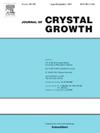Microcrystalline and nanocrystalline structure of diamond films grown by MPCVD with nitrogen additions: Study of transitional synthesis conditions
IF 1.7
4区 材料科学
Q3 CRYSTALLOGRAPHY
引用次数: 0
Abstract
This research explores the complex influence of nitrogen concentration and substrate temperature on the resultant properties of polycrystalline diamond (PCD) films grown by microwave plasma chemical vapor deposition (CVD). In particular, we investigated the growth parameters to find the exact conditions for changing the morphology of the resulting film from microcrystalline (MCD) to nanocrystalline (NCD). A series of 2 µm-thick polycrystalline diamond films was grown on Si substrates in methane-hydrogen–nitrogen gas mixtures with varied: (i) nitrogen concentration (0–2 %) and (ii) substrate temperature (700–1050 °C). Comprehensive characterization techniques, including scanning electron microscopy (SEM), micro-Raman spectroscopy, and X-ray diffraction, were employed to assess the morphological, structural, and spectroscopic properties of the films. The study reveals that even minor additions of nitrogen significantly modulate secondary nucleation, impacting both film morphology and phase composition. Furthermore, substrate temperature emerges as another critical parameter, influencing the growth kinetics and crystallite size. The comparison of the characteristics of grown PCD films allowed us to find conditions for the formation of NCD films with minimal surface roughness and maximal growth rate: nitrogen concentration [N2] ≈ 0.2–0.5 % and temperature T ≈ 850–900 °C. These findings can be used to optimize the CVD synthesis parameters of PCD films for applications as protective or friction-reducing layers, as well as for superhard cutting tools and optical devices.
添加氮气的 MPCVD 法生长的金刚石薄膜的微晶和纳米晶结构:过渡合成条件研究
本研究探讨了氮浓度和基底温度对微波等离子体化学气相沉积(CVD)法生长的多晶金刚石(PCD)薄膜性能的复杂影响。特别是,我们对生长参数进行了研究,以找到改变薄膜形态(从微晶(MCD)到纳米晶(NCD))的确切条件。在甲烷-氢气-氮气混合物中,在硅基底上生长了一系列 2 微米厚的多晶金刚石薄膜,氮气浓度(0-2%)和基底温度(700-1050 °C)各不相同。综合表征技术包括扫描电子显微镜(SEM)、微拉曼光谱和 X 射线衍射,用于评估薄膜的形态、结构和光谱特性。研究结果表明,即使添加少量氮也会显著调节二次成核,影响薄膜的形态和相组成。此外,基底温度也是影响生长动力学和晶体尺寸的另一个关键参数。通过比较生长的 PCD 薄膜的特性,我们找到了形成表面粗糙度最小、生长速率最大的 NCD 薄膜的条件:氮浓度 [N2] ≈ 0.2-0.5 %,温度 T ≈ 850-900 °C。这些发现可用于优化 PCD 薄膜的 CVD 合成参数,以用作保护层或减摩层,以及超硬切削工具和光学设备。
本文章由计算机程序翻译,如有差异,请以英文原文为准。
求助全文
约1分钟内获得全文
求助全文
来源期刊

Journal of Crystal Growth
化学-晶体学
CiteScore
3.60
自引率
11.10%
发文量
373
审稿时长
65 days
期刊介绍:
The journal offers a common reference and publication source for workers engaged in research on the experimental and theoretical aspects of crystal growth and its applications, e.g. in devices. Experimental and theoretical contributions are published in the following fields: theory of nucleation and growth, molecular kinetics and transport phenomena, crystallization in viscous media such as polymers and glasses; crystal growth of metals, minerals, semiconductors, superconductors, magnetics, inorganic, organic and biological substances in bulk or as thin films; molecular beam epitaxy, chemical vapor deposition, growth of III-V and II-VI and other semiconductors; characterization of single crystals by physical and chemical methods; apparatus, instrumentation and techniques for crystal growth, and purification methods; multilayer heterostructures and their characterisation with an emphasis on crystal growth and epitaxial aspects of electronic materials. A special feature of the journal is the periodic inclusion of proceedings of symposia and conferences on relevant aspects of crystal growth.
 求助内容:
求助内容: 应助结果提醒方式:
应助结果提醒方式:


